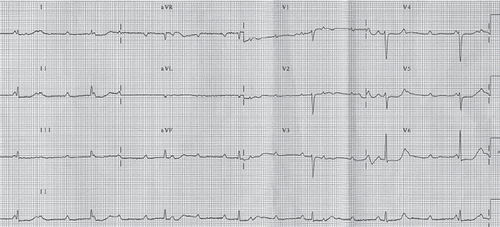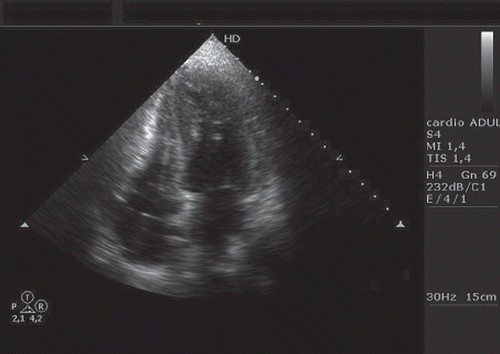Abstract
We report the case of a 65-year-old woman with complete atrio-ventricular block who underwent orciprenaline administration and pacemaker implantation. The intervention was complicated by pneumothorax and acute left ventricular systolic dysfunction with typical apical ballooning (Tako-Tsubo like syndrome). The patient was treated with diuretics and calcium-sensitizers and completely recovered. We speculate that both external and internal catecholamine triggered an acute left ventricular impairment with typical Tako-Tsubo features.
Background
Tako-tsubo syndrome (TTS) is characterized by acute onset of chest symptoms, ECG changes with elevated cardiac markers mimicking acute myocardial infarction, left ventricular (LV) wall motion abnormalities in the apical region with preserved function of base, and normal coronary arteries (Citation1). It typically follows stressful triggers, which could be either emotional or physical (Citation2–3). Catecholamine excess has been proposed in the determinism of TTS (Citation4–5), although the mechanism underlying TTS has not been completely described yet.
Case report
We report the case of a 65-year-old woman, referred for worsening dyspnoea, appeared since a week. She had no history of heart disease or cardiovascular risk factors and was not receiving any drug therapy. Arterial blood pressure at admission was 140/80 mmHg, and physical examination was unremarkable.
Resting ECG showed sinus tachycardia (100 bpm) and complete atrio-ventricular (AV) block (with a narrow QRS rhythm, 40 bpm) (). Chest radiography at admission showed no sign of pulmonary congestion, with a mildly enlarged cardiac transverse diameter. Blood tests revealed normal cholesterol, troponin and creatinine levels. At echocardiography examination, mild systolic dysfunction (50% LV ejection fraction; LVEF) and moderate mitral and aortic regurgitation were detectable.
The patient was scheduled for definitive bicameral pacemaker implantation: meanwhile, an infusion of orciprenaline was started. The day after admission, the patient underwent pacemaker implantation; a few hours later, she complained of severe dyspnoea. Chest radiography was repeated, showing left apical pneumothorax and left basal pleural effusion.
At echocardiography examination, a severe systolic dysfunction (25% LVEF) and apical dyskinesis with basal hyperkinesis (typical apical ballooning), () were unexpectedly found. ECG examination was not useful since ST segment was conditioned by pace-maker activity.
Figure 2. Acute left ventricular ballooning at two-dimensional echocardiography (a) systole, (b) diastole.

Therapy with loop diuretics and levosimendan was required for symptom relief and following blood tests showed positive troponin I levels (peak 4.44 ng/ml).
The patient recovered within a week, when LVEF was documented as normal at echocardiography control () and chest radiography did not show any sign of pleural effusion or pneumothorax. Also mitral regurgitation (MR) completely recovered. A further coronary angiogram did not show any sign of significant coronary atherosclerosis ().
Discussion
To our knowledge, this is one of the first cases reporting an acute transient systolic dysfunction following pace-maker implantation. Other previous papers have reported cases of TTS associated with major surgery intervention and anaesthesia (Citation6). Artukoglu et al. recently described a case of TTS in an anaesthetised patient undergoing arthroscopic knee surgery (Citation6). Moving to the field of interventional cardiac electrophysiology, Mawad et al. reported a case of TTS following transcatheter radiofrequency ablation of the AV node (Citation7). Authors speculate that increased sympathetic activity accompanying AV node ablation contributed to the pathophysiological process, which involves increased catecholamines and/or apical adrenoreceptor density and responsiveness. Leung et al. described a case of transient LV apical ballooning associated with atrial fibrillation (Citation8).
The mechanism hypothesized to be responsible for acute systolic dysfunction was acute catecholamine release. Spes et al. reported a case of recurrent TT phenomenon, which at work-up proved to be a pheochromocytoma (Citation5). Kume et al. documented increased local release of norepinephrine from the heart of patients with TTS. Authors conclude that increased cardiac catecholamines might cause the transient LV apical ballooning in these patients (Citation4). Induced reversible LV apical ballooning in rats experiencing emotional stress was normalized in experimental models by pre-treatment with adrenoceptor blockade (Citation2). Same authors suggest as activation of alpha-adrenoceptors and beta-adrenoceptors is the primary trigger of emotional stress-induced molecular changes in the heart (Citation3).
In our case, both external and internal catecholamines probably triggered the onset of TT phenomenon. Excess in internal adrenergic activation is common in subjects with complete AV block (Citation9), presumably representing a finalized compensative mechanism. Moreover, acute respiratory distress consequent to pneumothorax may increase catecholamine circulating levels (Citation10). In our case, both internal triggers of catecholamine release (AV block, respiratory distress, surgical distress) and infused external catecholamines (orciprenaline) were present. All these concomitant factors may have suddenly impaired LV systolic function, leading to transient apical ballooning.
As reported in previous papers, a transient MR was also present during acute LV dysfunction (Citation11); however, MR completely recovered simultaneously with LVEF.
Acknowledgement
The IRB reviewed and approved the study.
Declaration of interest: The authors report no conflicts of interest. The authors alone are responsible for the content and writing of the paper.
References
- Donohue D, Movahed MR. Clinical characteristics, demographics and prognosis of transient left ventricular apical ballooning syndrome. Heart Fail Rev. 2005;10:311–6.
- Ueyama T, Kasamatsu K, Hano T, Yamamoto K, Tsuruo Y, Nishio I. Emotional stress induces transient left ventricular hypocontraction in the rat via activation of cardiac adrenoceptors: A possible animal model of ‘tako-tsubo’ cardiomyopathy. Circ J. 2002;66: 712–3.
- Ueyama T, Senba E, Kasamatsu K, Hano T, Yamamoto K, Nishio I, . Molecular mechanism of emotional stress-induced and catecholamine-induced heart attack. J Cardiovasc Pharmacol. 2003;41(Suppl. 1):S115–8.
- Kume T, Kawamoto T, Okura H, Toyota E, Neishi Y, Watanabe N, . Local release of catecholamines from the hearts of patients with tako-tsubo-like left ventricular dysfunction. Circ J. 2008;72:106–8.
- Spes C, Knape A, Mudra H. Recurrent tako-tsubo-like left ventricular dysfunction (apical ballooning) in a patient with pheochromocytoma—a case report. Clin Res Cardiol. 2006;95:307–11. Epub 2006 Mar 22.
- Artukoglu F, Owen A, Hemmerling TM. Tako-Tsubo syndrome in an anaesthetised patient undergoing arthroscopic knee surgery. Ann Card Anaesth. 2008;11:38–41.
- Mawad W, Guerra PG, Dubuc M, Khairy P. Tako-tsubo cardiomyopathy following transcatheter radiofrequency ablation of the atrioventricular node. Europace. 2007;9:1075–6. Epub 2007 Jul 31.
- Leung Ki EL, Delabays A, Lyon X, Pruvot E. A case of recurrent transient left ventricular apical ballooning associated with atrial fibrillation. Int J Cardiol. 2007;118:e35–8. Epub 2007 Mar 28.
- Braunwald E. Atrioventricular dissociation. Braunwald E, Zipes DP, Libby P. Heart diseases: A textbook of cardiovascular medicine. 6th. Philadelphia, Pa: WB Saunders Co; 2001.
- Paratz J, Lipman J. Manual hyperinflation causes norepinephrine release. Heart Lung 2006;35:262–8.
- Brunetti ND, Ieva R, Rossi G, Barone N, De Gennaro L, Pellegrino PL, . Ventricular outflow tract obstruction, systolic anterior motion and acute mitral regurgitation in Tako-Tsubo syndrome. Int J Cardiol. 2007;127:e152–7.


